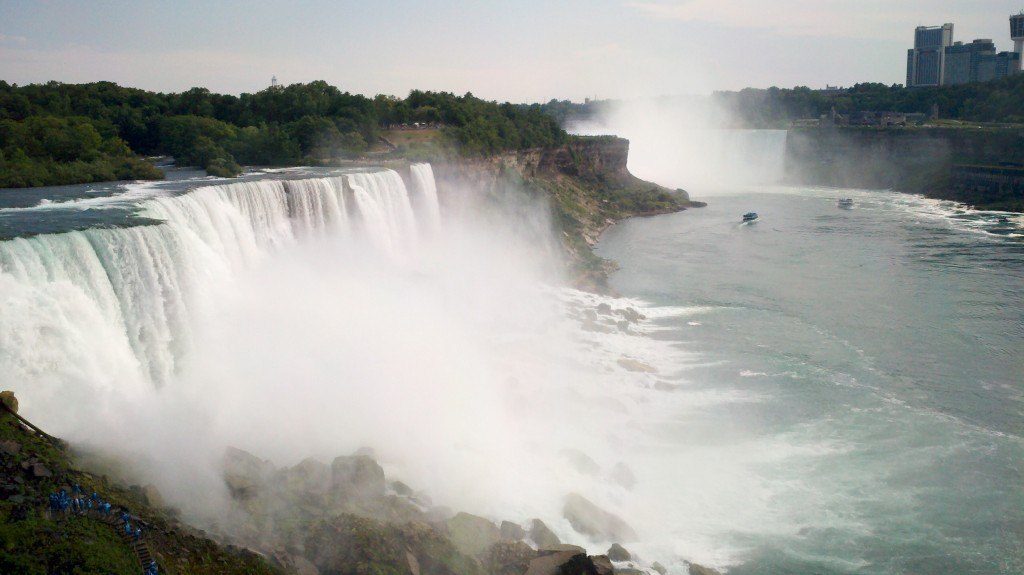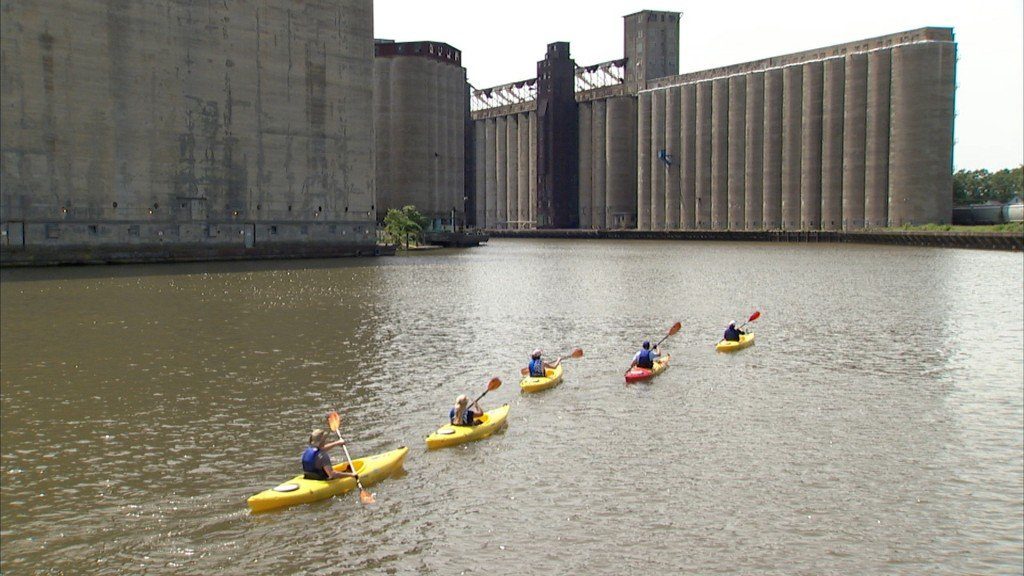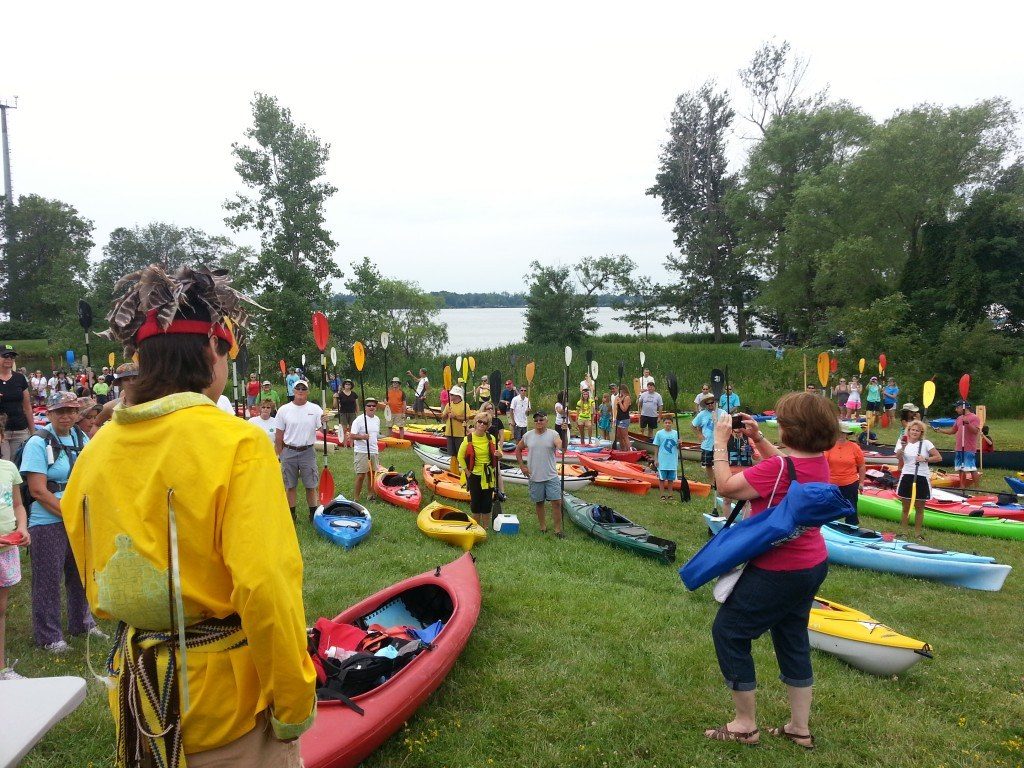From Rust To Blue
By: ajcarapella
Buffalo Niagara Riverkeeper is transforming its region’s waterways from industrial casualties to catalysts for rebirth.
By Devon Dams-O’Connor

Buffalo, New York goes by two nicknames: “The Queen City of the Lakes,” for its historical importance as a Great Lakes industrial hub; and “The City of Good Neighbors,” given for the way her people band together without fail to help each other do what needs to be done. When it comes to the region’s rivers and lakes, it was the first moniker’s origins that caused the waterways to become some of the most polluted in the country. But it is the second reputation, led by nonprofit Buffalo Niagara Riverkeeper, that is at the crux of restoring and reviving them.
The city sits at the confluence of the Niagara River, Lake Erie, the Buffalo River, and the original terminus of the Erie Canal. Its outskirts and shores are crisscrossed with rail lines, and by the mid-1800s, Buffalo had become a key portal for the east-to-west movement of people and products. The location, combined with ready access to fresh water and inexpensive hydropower from nearby Niagara Falls, made Buffalo a key player in the country’s westward expansion, and later, in its war efforts as steel, chemicals, and grain were processed and shipped from the region.
When industry began to wane in the years following World War II, residents started to realize just how dirty their water had become. By then, decades of industrial and municipal wastewater discharges, neither governed by laws designed to protect natural resources, had already taken a heavy toll on Western New York’s waterways.
As early as the 1940s, local advocates like Stanley Spisiak, known as “Mr. Buffalo River,” were instrumental in getting the state and federal governments to pay attention to the plight facing rust-belt waterways. In 1965, he hosted New York U.S. Senator Robert F. Kennedy on a visit to the Buffalo River, which the senator deemed “shocking” and a “danger to local water supplies.” In 1966, Spisiak hosted President Lyndon Johnson to tour the area’s former industrial arteries by boat, and after being shown a bucket of Buffalo River sludge, the president returned to Washington and signed an executive order halting the dumping of dredge spoils into Lake Erie. But in 1968 the rainbow-slicked surface of the Buffalo River caught fire and a lagging economy and population exodus following Buffalo’s steel plant closures put environmental concerns on the back burner while the city tried to recover, leaving the rivers and lake in a state of neglect.
When, in 1989, the Buffalo River and Niagara River were named federal Areas of Concern (AOC) and two of the 43 most toxic Great Lakes hotspots a handful of community members rallied together to form the Friends of the Buffalo River, which would later become Buffalo Niagara Riverkeeper. Founders included a professor of architecture and planning, an environmental attorney, grassroots activists, citizens and elected officials, and together they drew up a plan to hold the state and federal governments accountable for river remediation plans that had stagnated.
The problems they faced were monumental. Tests revealed over 100 chemical constituents present in Buffalo River sediment. The New York State Department of Health advised children under 15 and women under 50 to avoid consuming fish caught in local waters. Abutting brownfields, habitat destruction, and limited public access were all commonplace in a region dominated by industrial abandonment. But the group remained steadfast in its mission to chip away at the industrial legacy clouding the Great Lakes city’s future.
Over the next 25 years, Buffalo Niagara Riverkeeper would expand its focus to include the Niagara River and eastern Lake Erie; become the first non-profit organization in the Great Lakes Basin to be chosen by the U.S. Environmental Protection Agency (EPA) to coordinate and manage the implementation of a Remedial Action Plan; grow to include 25 staff members, a $5+ million budget, and over 40 programs; and gain the trust and support of the Western New York community.

From its inception, the lifeblood of Buffalo Niagara Riverkeeper’s work has been its ability to engage its neighbors and connect public and private entities to get real work done. In the early ’90s the group spent a lot of time convincing residents that clean water wasn’t just an “environmentalist” issue, but one that benefitted everyone who drinks it and lives near it.
“Breaking down barriers was the common theme of our work from the beginning,” says Buffalo Niagara Riverkeeper Executive Director Jill Spisiak Jedlicka (coincidentally, the grandniece of early river advocate Stanley Spisiak). “The unique role we took early on was to both serve as an advocate and collaborator, depending on the situation.”
That ability has led Buffalo Niagara Riverkeeper to engage over 200 partners through its 25-year history, from local advocacy groups and public broadcasting stations to the Canadian government, U.S. agencies, and corporations with a global reach.
“We sometimes refer to ourselves as ‘translators’ because we have to be able to communicate with a broad range of constituents, including the U.S. Army Corps of Engineers, the EPA, state agencies, the scientific community, activists, the public…” says Jedlicka. “It sometimes means we partner and collaborate with organizations that don’t always agree with each other, but that’s what needs to happen to find the best means to the ends we’re trying to achieve for our community.”
A perfect example of aligning opposing interests is the nearly completed cleanup of the Buffalo River, a $100 million effort supported by the Great Lakes Restoration Initiative, spearheaded by the EPA and Army Corps, the New York State Dept. of Environmental Conservation, Honeywell, and Buffalo Niagara Riverkeeper. As an industrial entity with operations on the riverbank, Honeywell has some liability in the waterway’s health. Buffalo Niagara Waterkeeper considered a litigious solution, but instead chose to leverage policy tools and collaborate with the industrial manufacturer. Early on, Buffalo Niagara Riverkeeper received push back from other environmental groups who questioned the organization’s integrity, but Jedlicka firmly believes the readiness to compromise was in the best interests of the river and the community in the long run.

Another example of finding common ground to improve the current and future health of the region’s waterways is the organization’s work with the Buffalo Sewer Authority (BSA). In just seven years, Buffalo Niagara Riverkeeper went from presenting the BSA with its “Golden Toilet Award” for the sewer overflows plaguing the region for generations, to securing a $92 million commitment by the BSA that involves not only a marked increase in green infrastructure, but also a partnership with another local non-profit for workforce training to operate and maintain it.
“I don’t think anyone in Buffalo has ever come up with a reason of why there is so much civic engagement in our community,” says Jedlicka. “The civic culture of the city is that it just keeps drawing people in, and luring expatriates back home, to get involved. It works here, and it could work elsewhere, too.” Buffalo Niagara Riverkeeper hosts plenty of opportunities for neighbors to roll up their sleeves and help. There are watershed courses, public forums, kayak tours, rain barrel programs, environmental leadership training for disadvantaged teens, volunteer water quality monitoring, shoreline restoration, cleanups, and more.
“It all starts with community education and mobilization,” Jedlicka says. “When you can get people demanding access to the waterways, coming out to public meetings, filing public comments, using social media, and generating news stories, you start to shift thinking. Elected officials, developers, and decision-makers are going to respond to what the people demand. As environmentalists and Waterkeepers, we have both a responsibility and an opportunity to drive civic engagement, and that’s the beauty of what grassroots organizations can do.”
Buffalo Niagara Riverkeeper’s work has earned an audience beyond Western New York as well. In 2015 the organization received global recognition as the recipient of the International River Foundation’s inaugural North American RiverPrize for excellence in river restoration and protection. In March, Jedlicka and members of the Healing Our Waters-Great Lakes Coalition traveled to Washington, D.C., where they met with several senior administration officials in the White House including the president’s senior advisor on environmental quality. Jedlicka was invited to share the success stories surrounding the Buffalo River and discuss what kind of policy actions are needed to continue the organization’s work.
But perhaps more importantly, the results of the organization’s efforts are most palpable at home. The shift in public focus toward water quality has begun to refurbish Buffalo’s rust-belt waterfront with community-driven investment in ecotourism, culture, recreation, and alternative energy. New waterfront developments like Canalside, Riverfest Park, and Solar City – often cited as some of the most convincing evidence of the city’s rebirth – are possible because the water is cleaner; the Buffalo River is on a trajectory to be delisted as a federal AOC by 2019.
“Buffalo Niagara Riverkeeper has had a tremendous impact on the Great Lakes region’s waterways,” says Senator Charles E. Schumer, United States Senator for New York. “Through their vision and leadership, the Buffalo River restoration is driving the region’s waterfront revitalization. Their advocacy and action is essential to protecting the health of our Great Lakes.”
At the heart of Buffalo’s new water based economy is a Buffalo River now lined with green spaces, performance venues, kayak launches, historical markers, and bike lanes where demolition debris, abandoned structures, and trash spilled over the banks just a decade ago. In total, close to $170 million in private investment is at work along the banks of the Buffalo River. These attractions are bringing more people than ever down to the waterfront, creating throngs of stewards with stronger connections to their waterways. A movement to dismantle a highway that has been a barrier between the community and the Niagara River promises to do the same, and this model can continue to play out throughout the 1,400 square mile watershed.
“Twenty-five years of advocacy and restoration work has helped re-connect the region to its Great Lakes heritage, and our cities and towns are now re-branding themselves around the importance of fresh water,” says Jedlicka. “How many communities get to re-invent themselves like that? This is by far Buffalo Niagara Riverkeeper’s greatest accomplishment.”
Devon Dams-O’Connor is a freelance journalist whose work focuses on farming, food, land, outdoor recreation, big ideas, and the people who make the stories happen. She lives and works in Buffalo, New York.
To learn more about the work of Buffalo Niagara Riverkeeper, visit www.bnriverkeeper.org.